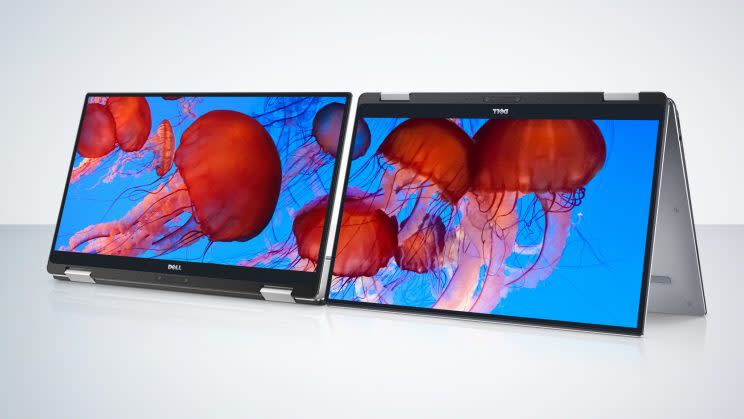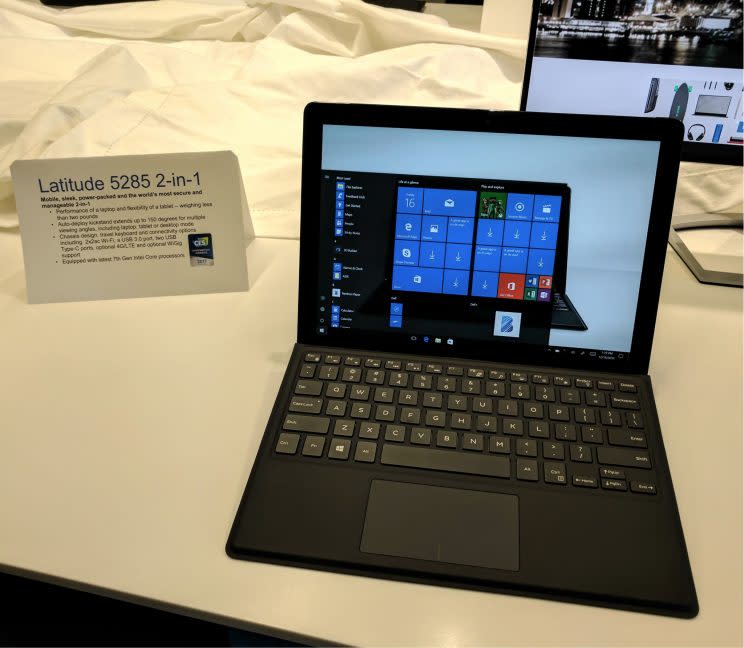Dell is kicking off CES 2017 with slick new laptops that double as tablets

On Thursday, Jan. 5 at 1 p.m. EST, Yahoo Finance will livestream Dell’s press conference at CES, the consumer technology show in Las Vegas.
Dell is rolling into CES 2017 with two new 2-in-1 laptops that are worth checking out. The first is a new version of the company’s excellent XPS 13 notebook, while the second is a direct competitor of Microsoft’s Surface Pro 4. Both double as tablets.
First thing’s first, though, is the new XPS 13. Dubbed the XPS 13 2-in-1 and available Jan. 5 for $999, the new model can be used as both a standard laptop and a tablet when you flip its display around. That means you can go from typing your TPS reports to watching movies on the couch with ease. The 2-in-1 is every bit as attractive and well-built as the original XPS 13, which is still one of my favorite laptops on the planet. Heck, I even got one for my mom.
This XPS 13 2-in-1 is slimmer than the standard XPS 13 thanks to its new fanless design. In fact, Dell says the 2-in-1 fits its 13-inch display into an 11-inch body thanks to its extremely thin InfinityEdge bezel.
Speaking of the 2-in-1’s screen, it’s every bit as bright and vibrant as the regular XPS 13, which is a huge compliment. The base model of the 2-in-1 comes with a standard 1080p resolution panel, though you can always bump that up to a QHD resolution screen.
To make use of the system’s 2-in-1 design, Dell will sell an optional Dell Active Pen stylus so you can write directly on the laptop’s display.

The Dell XPS 13 is such a great computer because of its slim design and powerful performance thanks to Intel’s Core i5 and i7 processors. But the XPS 13 2-in1 won’t get those same chips.
See in order to ensure the 2-in-1 used a fanless design, Dell had to opt for Intel’s new Core M versions of the i5 and i7. That means you might not get the same kind of firepower you’d expect of the XPS 13. Still, it should be more than enough for most everyday users.
Also of note is the fact that the XPS 13 2-in-1 only uses USB C ports. That’s the exact same reason I, and many other reviewers, criticized Apple’s new MacBook Pros. But unlike Apple (AAPL), Dell has included a USB C to standard USB adapter with the XPS 13 2-in1, so you’ll still be able to use at least one standard USB device without having to shell out cash for an adapter.
If the XPS 13 2-in-1 can manage to be as good as the standard XPS 13, Dell might just have two of the best Windows PCs on its hands. We’ll have to wait for our full review to know for sure, though.
Surface Pro 4 competitor

In addition to the XPS 13 2-in-1, Dell is showing off a new laptop/tablet hybrid aimed squarely at taking on Microsoft’s excellent Surface Pro 4. Available Feb. 28 and starting at $899, the Latitude 5285 — it really needs a catchier name — features styling similar to the Surface Pro 4, with a slight twist.
Like Microsoft’s 2-in-1, the Latitude 5285 can be used as a standalone tablet. A detachable keyboard pulls double duty as the tablet’s cover and a standard notebook keyboard when using the 5285 in laptop mode.
Just like the Surface Pro 4, the Latitude 5285 sports a 12.3-inch touch screen display. Though unlike the Surface, which has a brilliant 2736 x 1824 resolution panel, the Latitude 5285 gets a 1080p display. That would be a problem if the 5285 were being marketed to consumers, but Dell is aiming this 2-in-1 for the enterprise market where super-high resolution screens aren’t exactly necessary.
One of my biggest gripes about the Surface Pro 4 is that the keyboard, which you would think comes with the system, is actually a $130 accessory. And unfortunately, Dell has followed the same path making the Latitude’s travel keyboard an optional add-on. Pricing for that isn’t available just yet.
In terms of performance, the Latitude 5285 is neck-and-neck with the Surface Pro 4. You can get Intel’s Core i-series processors (7th-generation), up to 16GB of RAM and up to a 1TB SSD.

Unlike the Surface, though, the Latitude includes two USB C ports. Don’t worry, there’s also a standard USB 3.0 slot.
The one big difference between the Latitude and Surface, well besides their displays, is how you pop out the Latitude’s built-in kickstand. See, unlike the Surface, which lets you pull out the kickstand from the back of the tablet, the Latitude actually pops it out for you when you push the tablet down on a hard surface. It’s a pretty neat little mechanism, but definitely not something that should factor into your buying decision.
Those aren’t the only devices Dell is showing off at CES 2017. So be sure to tune in to the company’s big press conference live on Yahoo Finance.
More from CES:
What to expect this week at CES, the world’s biggest gadget show
Fiat Chrysler’s Portal concept is an upgradable car for millennials
The Norton Core is a beautiful Wi-FI router that protects your digital home
Samsung’s new washing machine will save you time and aggravation
The biggest busts from the world’s most renowned gadget show
Email Daniel at [email protected]; follow him on Twitter at @DanielHowley.
